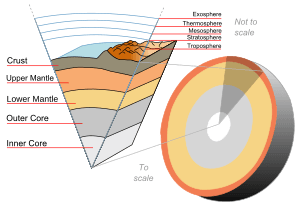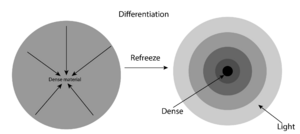Earth's outer core facts for kids
Earth has several layers, and one of the most important is the outer core. It's a super hot, liquid layer found deep inside our planet. This layer is mostly made of melted iron and nickel. It sits right above Earth's solid inner core and below the mantle. The outer core starts about 2,889 kilometers (1,795 miles) below Earth's surface and goes down to about 5,150 kilometers (3,200 miles) deep.
Contents
What is the Outer Core Like?
The outer core is different from the inner core because it's liquid, not solid. Scientists know this because of how earthquake waves travel through Earth. Special waves called "shear-waves" (S-waves) can't go through liquids. Since these waves stop at the outer core, it tells us it's a fluid. Even though it's made of similar stuff to the solid inner core, there isn't enough pressure in the outer core to make it freeze solid.
Scientists estimate the outer core's temperature is incredibly hot, ranging from about 3,000 to 4,500 Kelvin (about 2,700 to 4,200 Celsius or 4,900 to 7,600 Fahrenheit) in its outer parts. Closer to the inner core, it can be even hotter, from 4,000 to 8,000 Kelvin (about 3,700 to 7,700 Celsius or 6,700 to 13,900 Fahrenheit). Because it's so hot and liquid, the outer core is always moving and swirling around. This movement is very important for our planet.
The swirling motion of the liquid iron and nickel in the outer core creates Earth's magnetic field. This is called the dynamo theory. Think of it like a giant electric generator deep inside Earth! The magnetic field in the outer core is about 50 times stronger than the one we feel on the surface.
As Earth slowly cools down, the liquid iron at the edge of the inner core starts to freeze. This makes the solid inner core grow bigger, bit by bit. It's like ice forming in a very hot drink. This process adds about 1 millimeter (0.04 inches) of new solid core every year.
Light Elements in the Outer Core
Why are there "Light" Elements?
Scientists believe the outer core isn't just pure iron and nickel. If it were, it would be much denser than what our measurements show. The outer core is actually about 5 to 10 percent less dense than pure iron would be at those extreme temperatures and pressures. This means there must be lighter elements mixed in. These are elements with a low atomic number, like hydrogen, carbon, oxygen, silicon, and sulfur.
Scientists can't directly sample the outer core. So, they use clues from high-pressure experiments, earthquake wave data, and studies of how Earth formed. They also compare Earth's composition to special meteorites called CI chondrites. These meteorites are thought to have the same elements in the same amounts as the early Solar System.
How Light Elements Help Us Understand Earth
Understanding these light elements helps us learn more about how Earth formed and how its core came to be.
Earth's Formation Clues
The types of light elements in the outer core give us hints about what Earth was like when it was first forming. For example, these elements had to be common when Earth was young. They also needed to be able to mix with liquid iron and not escape into space as gases during Earth's early, hot stages.
By studying how much silicon is in Earth's primitive mantle (the layer above the core) compared to CI meteorites, scientists can guess how much silicon might have gone into the core. This helps us understand how Earth's different layers separated.
Core Formation Clues
The way certain elements, like siderophile elements (elements that like to mix with iron), are missing from Earth's mantle compared to meteorites tells us about the chemical reactions that happened when Earth's core was forming. These reactions depend on elements like oxygen, silicon, and sulfur. So, knowing their amounts in the outer core helps us understand the conditions when the core first formed.
For example, if hydrogen is in the outer core, it suggests that Earth's water wasn't just added at the very end of its formation. It might have been absorbed into the core-forming metals when Earth was a hot, melted "magma ocean."
Why Light Elements Matter for Earth's Magnetic Field

Earth's magnetic field is powered by the movement of the liquid outer core. This movement is caused by heat (thermal convection) and also by the light elements (chemical convection). As the inner core grows, it pushes out these lighter elements. These lighter elements then float upwards in the liquid outer core, while denser elements sink. This movement releases energy, which helps power the geodynamo that creates Earth's magnetic field.
Scientists think that chemical convection (the movement of light elements) contributes more to the magnetic field's power than thermal convection (movement due to heat). This magnetic field is super important! It protects all life on Earth from harmful radiation from space and stops our atmosphere from being blown away by the solar wind.
Scientists are still trying to figure out exactly how much the core is cooling and how long the magnetic field will last. But don't worry, current estimates suggest the core won't freeze solid for billions of years. That's long after the Sun is expected to expand and change our planet!
See also
- Hollow Earth
- Geological history of Earth
- Large low-shear-velocity provinces
- Lehmann discontinuity
- Rain-out model
- Seismic tomography – a way to map Earth's inside using earthquake waves
- Travel to the Earth's center
- Solid earth




